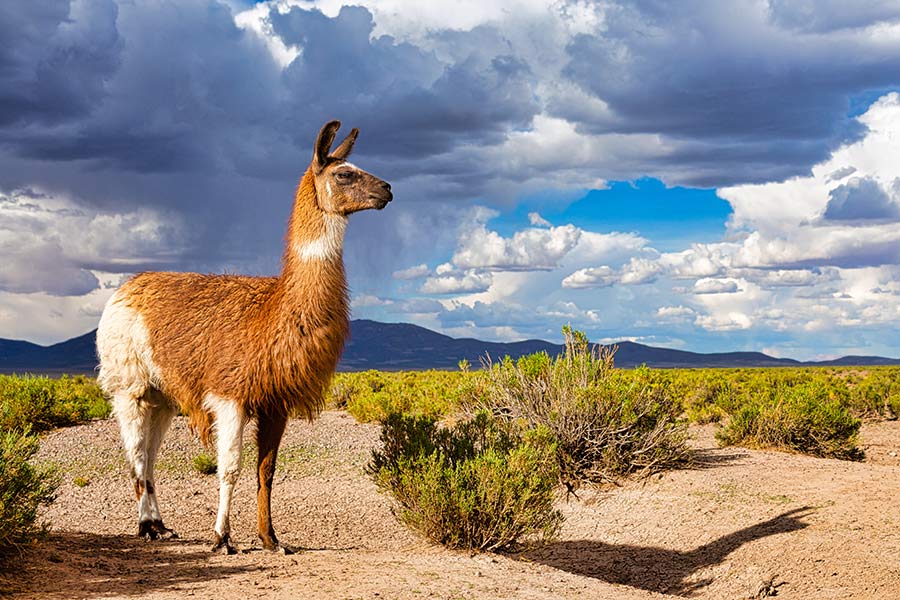Guard Llamas

by Dr. William L. Franklin and Kelly J. Powell
Iowa State University June 1993
A Research Report funded in part by Rocky Mountain Llama & Alpaca Association
Reprinted from RMLA newsletter
Guard llamas offer a viable, nonlethal alternative for reducing predation while requiring no training and little care.
Coyote predation is a serious problem for the sheep industry. The traditional approach to controlling predator losses has been to trap and poison coyotes. During this study, 145 sheep producers using guard llamas were interviewed to determine characteristics of the guard llamas and husbandry practices. Some of the results include:
Most introductions require only a few days or less for the sheep and llama to adjust to each other.
The average ranch uses one gelded male llama pastured with 250 to 300 sheep in 250 to 300 acres.
Sheep and lamb losses averaged 26 head per year (11% of the flock) before using guard llamas and 8 head per year (1% of the flock) after.
More than half of guard llama owners report a 100 percent reduction in predator losses.
Llamas are introduced to sheep and pastured with sheep under a variety of situations, few of which affect the number of sheep lost to predators.
Multiple guard llamas are not as effective as one llama
Ranchers report an average annual savings of $1,034 and 86% say they would recommend guard llamas to others.
Protectiveness of sheep and easy maintenance are the two most commonly cited advantages.
Problems encountered include aggressiveness and attempted breeding of ewes, overprotection of flock, and sheep interference with llama feeding.
Overall, llamas are effective guards with high sheep producer satisfaction.
Although questions remain to be answered, guard llamas are a viable, non-lethal alternative for reducing predation, requiring no training and little care.
Coyote predation on sheep
Make no mistake about it: coyotes kill sheep. In fact, predation is a leading cause of sheep mortality and represents a serious problem for the sheep industry. Sheep losses due to predation in the United States were more than $83 million in 1987, up from $72 million in 1986 and $69 million in 1985. The losses in 1987 represent 5 percent of the total sheep population in the United States. Lambs are particularly vulnerable. Lamb losses from predation average 9 percent and vary from 3 percent to 14 percent of the lambs.
Sheep are found in every state of the union, and losses due to predation vary. In Iowa, the state with the largest number of sheep operations, intensive field studies revealed that 41 percent of all sheep losses were from canine predators (coyotes and dogs). Sheep scientist Clair Terrill calculated economic losses due to predation. In Texas, the state with the largest number of sheep, predation was responsible for 14 percent to 69 percent of all sheep losses. Texas also led the nation in economic loss due to predation on sheep ($12 million) followed by California ($9 million), Wyoming ($7 million), Iowa ($6 million), Utah ($6 million), and Colorado ($5 million).
For an industry operating on a low-profit margin, losses due to predation have resulted not only in reduced revenue for the producer but also in higher prices paid by the consumer for meat and wool products. Predation is a real problem with a major impact on the sheep industry.
Guard animals
Recently, the search for a simple, non-lethal technique to prevent coyote predation has led to the experimental and field use of guard animals. The ideal guard animal should protect sheep against coyote predation while requiring minimal training, care, and maintenance. It should stay with and not disrupt the flock and live long enough to be cost-effective. A variety of guard animals currently in use includes dogs, donkeys, kangaroos, ostriches, and llamas. Of these, guard dogs are by far the most common.
During the past decade and a half, with the birth and growth of the llama industry in North America, llamas were occasionally pastured with sheep. To the surprise of owners, they noticed fewer sheep were being lost to coyotes. As the word spread, producers started experimenting with guard llamas. Today, their use in North America is on the increase, but guard llamas still number only in the hundreds.
Did sheep losses decline?
Before producers obtained their guard llamas, they had been losing an average of 26 sheep per year to predation, or about 11 percent of their flocks. After obtaining their llamas, the producers' losses dropped significantly to an average of 8 head per year or about 1 percent; half of the producers had their losses reduced to zero. Eighty percent of the producers rate their guard llama's ability to reduce predation losses of their sheep as "very effective" or "effective."
Owner satisfaction, cost, and savings
Nearly 80% of the sheep producers reported that they are either "very satisfied" or "satisfied" with their guard llamas. Predator control and easy maintenance are cited as the top benefits. Two-thirds of the producers report no disadvantages with their guard llamas, and 85 percent indicate they would recommend guard llamas to others.
Some producers report no savings by having a guard llama, while one purebred producer saves an average of $20,000 per year. An average annual savings of $1,034 was reported by 86 producers.
Further topics covered in the brochure are: Reducing coyote predation; Traditional approaches; Non-lethal approaches; Introduction of llamas to sheep; Do guard llamas really work?; Current use of guard llamas; How and why do llamas protect sheep?; What works best?; Cautions and problems; Guard llamas vs. guard dogs; Not a panacea
This brochure entitled "Guard Llamas", is a 12-page study on the subject of "Do Guard Llamas Really Work?", published by Iowa State University in June 1993
Like this article? Become a RMLA Member today!

